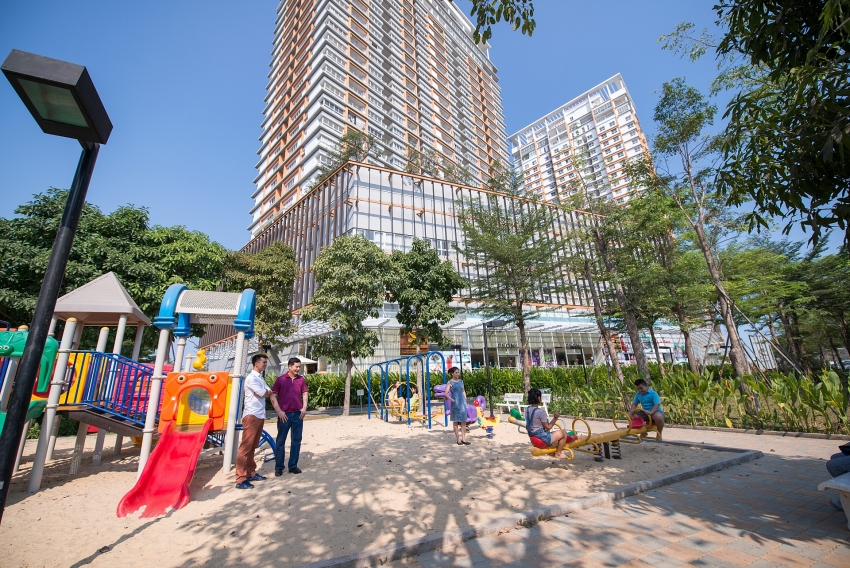Vietnam aims to utilise energy saving and environmental protection
According to the Department of Science, Technology and Environment under the Ministry of Construction (MoC), new buildings should pay attention to construction materials, air conditioning, and ventilation systems, lighting, elevators, automatic power cut-off, and hot water system to reduce their energy consumption.
 |
| The EECB aimed at cutting greenhouse gas emissions over the long run, will review and seek better energy-saving methods and create a framework for the task. |
MoC is establishing a legal framework to support energy savings in buildings, accomplishing green construction and economy.
Among these is the draft circular guiding activities to certify constructions using energy-saving and efficient natural resources and protecting the environment. This draft circular is being presented to experts and authorities to collect opinions and suggestions.
A project called “Energy Efficiency Improvement in Commercial and High-Rise Residential Buildings in Vietnam” (EECB) has been rolled out by the ministry since 2016 under the sponsorship of the United Nations Development Programme (UNDP).
This project aimed at cutting greenhouse gas emissions over the long run, will review and seek better energy-saving methods and create a framework for the task.
According to statistics from the MoC, there are more than 1,500 high-rise buildings in five cities of Vietnam ranging from 2,500 square metres each. These buildings are wasting a great deal of energy and releasing large volumes of greenhouse gas emissions.
In order to save energy for high-rise buildings and construction, efforts must be started from the very first step of the project, from design, construction, advanced technologies, and environmentally friendly equipment.
Currently, the industrial and construction sectors consume the largest volume of energy with around 54 per cent.
The largest portion of energy in large-scale constructions is consumed by air conditioning systems, accounting for 45 per cent in office buildings, 41 per cent in retail centres, and 42 per cent in hotels.
In addition, the lighting system is also occupying 13-25 per cent of the energy consumption.
According to research and statistics by relevant ministries and projects, the total energy consumption in the civil sector – including buildings and residential areas – accounts for about 37-40 per cent of the total national energy consumption.
Currently, there are many new technologies and products that also introduce energy-saving requirements in the construction investment process as well as the management and operation of civil works and housing.
Since 2005, the MoC has issued the Vietnam Construction Code No.09/2005 on energy-efficient constructions, stipulating that works with a total floor area of over 2,500 square metres must apply energy-saving solutions. For the smaller construction works, we have technical guidelines and standards to guide owners in the process of construction and installation of equipment.
The revised Construction Law in 2020 was passed by the National Assembly in which Article 10 stated that the government encourages investment activities in certifying construction works economically, using energy resources and protecting the environment.
This is the foundation for us to implement the regulations to create legal documents for activities to promote energy-saving and efficient works and environmental protection in practice.
We already know that these activities have taken place in Vietnam for many years. The green buildings have been certified by international organisations in Vietnam for nearly 20 years. Vietnam currently has more than 100 projects certified by international organisations.
However, the legal corridor on green building certification has not been set up despite its enormous socioeconomic significance.
What the stars mean:
★ Poor ★ ★ Promising ★★★ Good ★★★★ Very good ★★★★★ Exceptional
 Tag:
Tag:
Related Contents
Latest News
More News
- Heavy industries set for pilot greenhouse gas quotas (December 25, 2025 | 10:00)
- Swedfund invests in MSME growth and climate action in Vietnam (December 19, 2025 | 11:42)
- GreenYellow brings solar energy to light up remote schools in Tuyen Quang province (December 19, 2025 | 08:00)
- Charge+, Grab partner to develop EV charging network in Vietnam (December 18, 2025 | 17:11)
- Linking sci-tech and innovation to Vietnam’s net-zero future (December 18, 2025 | 14:31)
- Driving double-digit growth through green and circular transformation in Vietnam (December 17, 2025 | 09:00)
- Standard Chartered and ACCA deepen collaboration to develop Vietnam’s talent for a sustainable future (December 15, 2025 | 18:18)
- Schaeffler reports strong early output from Dong Nai solar project (December 12, 2025 | 15:16)
- Forestry conference highlights biodiversity and sustainability goals (December 09, 2025 | 13:35)
- Home Credit honoured among top 10 sustainable companies in trade and services (December 09, 2025 | 12:18)

























 Mobile Version
Mobile Version